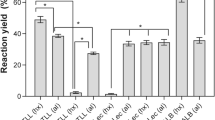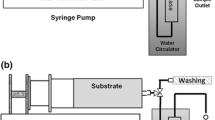Abstract
Selective ethanolysis of fish oil was catalyzed by immobilized lipases and their derivatives in organic media. Lipases from Candida antarctica B (CALB), Thermomyces lanuginosa (TLL) and Rhizomucor miehei (RML) were studied. The three lipases were immobilized by anion exchange and hydrophobic adsorption. The discrimination between the ethyl ester of eicosapentaenoic acid (EE-EPA) and the ethyl ester of docosahexaenoic acid (EE-DHA) depends on the lipase, the immobilization support, the physico-chemical modifications of the immobilized lipase derivatives and on the solvents used. TLL and RML were much more selective than CALB. EE-EPA is released 20-fold faster than EE-DHA when ethanolysis was catalyzed, in cyclohexane, by TLL hydrophobically adsorbed on Sepabeads C18. The selectivity and stability of the different derivatives in these polar organic solvents were further improved after physico-chemical modification. The best results for activity-selectivity-stability were obtained in cyclohexane for TLL adsorbed on Sepabeads C18 and further modified via solid-phase physical modification with a polyethylenimine polymer. In this case, the initial selectivity was higher than 20, and a 80 % of EPA was released as ethyl ester after 3 h at 25 °C. At this conversion, mixtures of ethyl esters highly enriched in the ethyl ester of EPA with less than 5 % of the EE-DHA were obtained. TLL derivatives remained fully active after incubation for 24 h in anhydrous solvents.



Similar content being viewed by others
References
Fernandez L, Banuelos O, Zafra A, Ronchel C, Perez-Victoria I, Morales JC, Velasco J, Adrio JL (2008) Alteration of substrate specificity of Galactomyces geotrichum BT107 lipase I on eicosapentaenoic acid-rich triglycerides. Biocatal Biotransform 26:296–305
Heird WC (2001) The role of polyunsaturated fatty acids in term and preterm infants and breastfeeding mothers. Pediatr Clin North Am 48:173–188
Demaison L, Moreau D (2002) Dietary n-3 polyunsaturated fatty acids and coronary heart disease-related mortality: a possible mechanism of action. Cell Mol Life Sci 59:463–477
Saremi A, Arora R (2009) The utility of omega-3 fatty acids in cardiovascular disease. Am J Ther 16:421–436
Antypa N, Van Der Does AJW, Smelt AHM, Rogers RD (2009) Omega-3 fatty acids (fish-oil) and depression-related cognition in healthy volunteers. J Psychopharmacol 23:831–840
Bougnoux P, Hajjaji N, Maheo K, Couet C, Chevalier S (2010) Fatty acids and breast cancer: sensitization to treatments and prevention of metastatic re-growth. Prog Lipid Res 49:76–86
Kralovec JA, Zhang S, Zhang W, Barrow CJ (2012) A review of the progress in enzymatic concentration and microencapsulation of omega-3 rich oil from fish and microbial sources. Food Chem 131:639–644
Yan J, Liu S, Hu J, Gui X, Wang G, Yan Y (2011) Enzymatic enrichment of polyunsaturated fatty acids using novel lipase preparations modified by combination of immobilization and fish oil treatment. Bioresour Technol 102:7154–7158
Treichel H, Oliveira D, Mazutti MA, Luccio MD, Oliveira JV (2010) A review on microbial lipases production. Food Bioprocess Technol 3:182–196
Haraldsson GG, Kristinsson B, Sigurdardottir R, Gudmundsson GG, Breivik H (1997) The preparation of concentrates of eicosapentaenoic acid and docosahexaenoic acid by lipase catalyzed transesterification of fish oil with ethanol. J Am Oil Chem Soc 74:1419–1424
Fernández-Lorente G, Pizarro C, López-Vela D, Betancor L, Carrascosa AC, Pessela B, Guisan JM (2011) Hydrolysis of fish oil by lipases immobilized inside porous supports. J Am Oil Chem Soc 88:819–826
Medina AR, Cerdán LE, Giménez AG, Páez BC, Ibáñez González MJ, Grima EM (1999) Lipase-catalyzed esterification of glycerol and polyunsaturated fatty acids from fish and microalgae oils. J Biotechnol 70:379–391
Rozieres MS, Deyris V, Comeau LC (2000) Enrichment of polyunsaturated fatty acids from sardine cannery effluents by enzymatic selective esterification. J Am Oil Chem Soc 77:329–332
Muñío MDM, Esteban L, Robles A, Hita E, Jiménez MJ, González PA, Camacho B, Molina E (2008) Synthesis of 2-monoacylglycerols rich in polyunsaturated fatty acids by ethanolysis of fish oil catalyzed by 1,3 specific lipases. Process Biochem 43:1033–1039
Fernandez-Lorente G, Filice M, Lopez-Vela D, Pizarro C, Wilson L, Betancor L, Avila Y, Guisan JM (2011) Cross-linking of lipases adsorbed on hydrophobic supports: highly selective hydrolysis of fish oil catalyzed by RML. J Am Oil Chem Soc 88:801–807
Bastida A, Sabuquillo P, Armisen P, Fernández-Lafuente R, Huguet J, Guisan Jose M (1998) A single step purification, immobilization, and hyperactivation of lipases via interfacial adsorption on strongly hydrophobic supports. Biotechnol Bioeng 58:486–493
Fernández-Lorente G, Godoy CA, Mendes AA, Lopez-Gallego F, Grazu V, de las Rivas B, Guisan Jose M (2008) Solid-phase chemical amination of a lipase from Bacillus thermocatenulatus to improve its stabilization via covalent immobilization on highly activated glyoxyl-agarose. Biomacromolecules 9:2553–2561
Carraway KL, Koshland DE Jr (1968) Reaction of tyrosine residues in proteins with carbodiimide reagents. Biochim Biophys Acta 160:272–274
Montes T, Grazú V, Manso I, Galán B, López-Gallego F, González R, Hermoso JA, García JL, Guisán JM, Fernández-Lafuente R (2007) Improved stabilization of genetically modified penicillin G acylase in the presence of organic cosolvents by co-immobilization of the enzyme with polyethyleneimine. Adv Synth Catal 349:459–464
Montes T, Grazu V, López-Gallego F, Hermoso JA, Guisán JM, Fernández-Lafuente R (2006) Chemical modification of protein surfaces to improve their reversible enzyme immobilization on ionic exchangers. Biomacromolecules 7:3052–3058
Mateo C, Palomo JM, Fernandez-Lorente G, Guisan JM, Fernandez-Lafuente R (2007) Improvement of enzyme activity, stability and selectivity via immobilization techniques. Enzyme Microb Technol 40:1451–1463
Acknowledgments
This work was sponsored by the Spanish Ministry of Science and Innovation (project AGL-2009-07526) We gratefully recognize the Spanish Ministry of Science and Innovation for the “Ramón y Cajal” contract for Dr. Fernandez-Lorente and for the FPI contract granted to Sonia Moreno-Perez. We would like to thank Novozymes and Ramiro Martinez for the generous gift of commercial lipases.
Author information
Authors and Affiliations
Corresponding authors
About this article
Cite this article
Moreno-Pérez, S., Guisan, J.M. & Fernandez-Lorente, G. Selective Ethanolysis of Fish Oil Catalyzed by Immobilized Lipases. J Am Oil Chem Soc 91, 63–69 (2014). https://doi.org/10.1007/s11746-013-2348-3
Received:
Revised:
Accepted:
Published:
Issue Date:
DOI: https://doi.org/10.1007/s11746-013-2348-3




